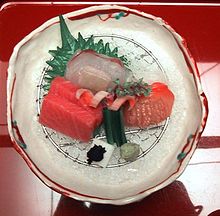Japanese Kaiseki ryori
Kaiseki, closely associated with tea ceremony (chanoyu), is a high form of hospitality through cuisine. The style is minimalist, extolling the aesthetics of wabi-sabi.
Like the tea ceremony, appreciation of the diningware and vessels is
part of the experience. In the modern standard form, the first course
consists of ichijū-sansai (one soup, three dishes), followed by
the serving of sake accompanied by dish(es) plated on a square wooden
bordered tray of sorts called hassun (八寸). Sometimes another element called shiizakana (強肴) is served to complement the sake, for guests who are heavier drinkers.
The tea ceremony kaiseki(懐石) is often confounded with another kaiseki-ryōri (会席料理),
which is an outgrowth of meals served at a gathering for haiku and
renga composition, which turned into a term for sumptuous
sake-accompanied banquet, or shuen (酒宴).














0 comments:
Post a Comment